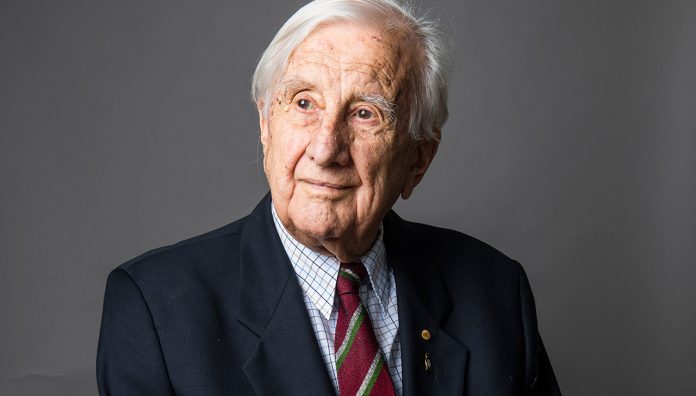Centenarian and PSA life member JSD ‘Stan’ Mellick OAM, ED, PhC, BA, PhD reflects on a 75-year association with pharmacy.
Where, when and why did you start your career in pharmacy?
I started studying by correspondence in 1945 in Queensland, pharmacy being the one course for which I met the entry requirements. I was engaged under a Dickensian apprenticeship agreement that dictated my behaviour – no alcohol or gambling and absolute adherence to the directions of the Master Chemist. I later transferred to the Brisbane General Hospital under the tutelage of Chief Chemist RSF Greig.
Can you outline some career and educational highlights?
When I qualified in 1949, I bought a pharmacy at Enoggera in Brisbane. In 1953 I opened another pharmacy in Brisbane city, and joined the Pharmaceutical Society around 1950. Post-war health issues resulted in my selling out in 1964 after which I joined the University of Queensland, ultimately gaining a PhD in literature at age 58. By then I had served in several areas of the Pharmaceutical Society, mainly concentrating on improving education for pharmacists. For me, the nature of pharmacy required a wider training in drugs and chemicals, something I pursued relentlessly until the mid-1950s when the iron-clad grip of the Pharmacy Board on content was replaced by a graduate course at the University of Queensland (UQ). I then became a member of UQ’s Board of Studies in Pharmacy. From 1970 until 2010, I was one of 14 partners in a day and night pharmacy.
What are the most significant changes you have seen between your start and retirement?
The replacement of the word ‘chemist’ with ‘pharmacist’; increased educational standards to keep pace with drugs and chemicals; the advent of modern pharmacies advocated by major pharmaceutical companies and the disappearance of prescription books and the advent of computers in the dispensary. I support innovation, such as the Pharmacy Board’s requirements regarding refresher studies to maintain registration and home visits by pharmacists to do a formal assessment of patient medicine.
What advice would you give early career pharmacists?
It depends on which field one enters – hospital, retail or manufacturing. The PSA leadership has outlined many targets for the profession to achieve and these should be supported unreservedly. Initiative and far-sightedness are vital. Focus on opportunities in the system and be a self-starter.
What challenges face the profession and how should pharmacists prepare?
My ultimate vision is for the profession to advise physicians on the most suitable drugs and chemicals for the condition involved. That vision requires briefing the pharmacist on the patient’s condition and the pharmacist making recommendations accordingly. In short, a joining of the physician’s need to know and the pharmacist’s extensive knowledge. Patients tend to vary in their observance of how and when they take their prescribed medicines. This becomes a factor in their treatment and as such should be checked by the pharmacist, even to the extent of home visiting to do so.
What is important for medicine safety in 2020 and beyond?
Pharmacists are under pressure to do more with less, with attendant risks on prescription filling. Non-pharmacist owners don’t understand that filling a prescription involves not just the counting of tablets but patient considerations, doctors’ requirements, legal obligations, and the filter of the pharmacist’s own knowledge. This all takes time. It follows that pharmacy should be controlled neither by the non-pharmacists nor companies. Shop pharmacy really disguises the true nature of the shop dispensary. How to cope with this will take a lot of consideration.



 Professor Margie Danchin[/caption]
Professor Margie Danchin[/caption]

 Dr Peter Tenni[/caption]
Dr Peter Tenni[/caption]
 How should we deprescribe gabapentinoids, according to the Maudsley Deprescribing Guidelines[/caption]
How should we deprescribe gabapentinoids, according to the Maudsley Deprescribing Guidelines[/caption]



 Pharmacists have always prescribed, but they have the potential to prescribe much more
Pharmacists have always prescribed, but they have the potential to prescribe much more




